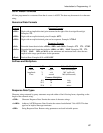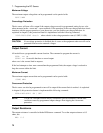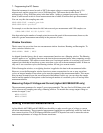
Programming the DC Source - 7
73
Triggering Output Changes
The dc source has two independent trigger systems. One is used for synchronizing output changes, and
the other is used for synchronizing measurements. This section describes the output trigger system. The
measurement trigger system is described under "Triggering Measurements".
SCPI Triggering Nomenclature
In SCPI terms, trigger systems are called sequences. When more than one trigger system exists, they are
differentiated by naming them SEQuence1 and SEQuence2. SEQuence1 is the transient trigger system
and SEQuence2 is the measurement trigger system. The dc source uses aliases with more descriptive
names for these sequences. These aliases can be used instead of the sequence forms.
Sequence Form Alias
SEQuence1 TRANsient
SEQuence2 ACQuire
Output Trigger Model
Figure 7-1 is a model of the output trigger system. The rectangular boxes represent states. Arrows show
the transitions between states. These are labeled with the input or event that causes the transition to
occur.
LEVEL
INITIATED STATE
IDLE STATE
A
BORt
*RCL
*RST
TRIGGER RECEIVED
INITiate
[
:IMMediate
]
INITiate:CONTinuous OFF
CHANGE
OUTPUT
INITiate:CONTinuous ON
Figure 7-1. Model of Output Trigger System
Setting the Voltage, Current, or Resistance Transient Levels
To program output trigger levels, you must first specify a voltage or current trigger level that the output
will go to once a trigger signal is received. Use the following commands to set the output trigger level:
VOLT:TRIG <n>
VOLT2:TRIG <n> for models that have a second output
CURR:TRIG <n>
CURR2:TRIG <n> for models that have a second output
RES:TRIG <n> only applies to output 1 (the main output)
NOTE: Until they are programmed, trigger levels will be the same as the corresponding voltage
or current levels. For example, if a dc source is powered up and the voltage is
programmed to 6, the trigger level is also set to 6. Once you program a trigger level, it
will stay at that value until the output is changed by a transient trigger or reprogrammed.


















